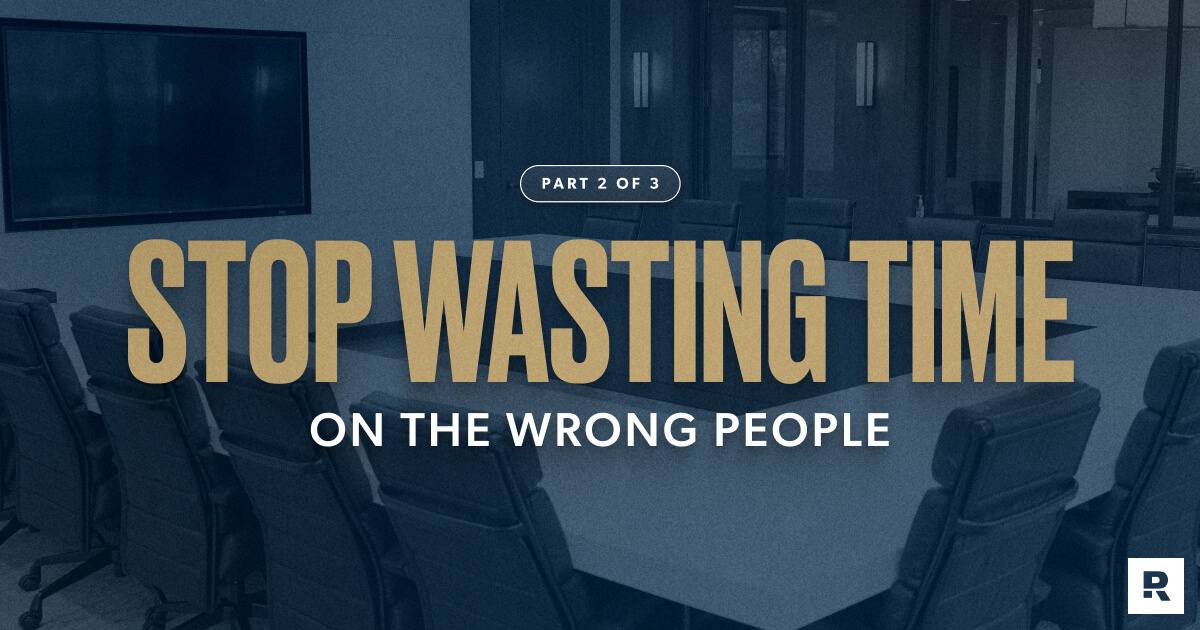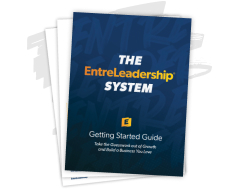Selling by Serving Part 2: How to Master the Sales Process
9 Min Read | Jun 30, 2025

Key Takeaways
- Selling and serving aren’t at odds. Helping people make confident, informed decisions is what great selling looks like.
- Qualification saves time (and awkward conversations). If someone doesn’t have the money, time, need or authority, they’re not a qualified buyer.
- Rapport builds trust faster than a sales pitch ever could. Network, do your homework, and adapt to how they buy—not how you like to sell.
- People buy from people they like and trust. When you serve the right people well and build rapport, the sale becomes a natural next step.
- Education is about being a trusted advisor. Know your stuff, believe in it, and help people understand how it solves their problems.
You want to serve your customers well—but you also want to sell. Sound like you? That’s not a contradiction. In fact, the best salespeople know the two go hand in hand. Serving people well is how you sell.
In Part 1 of this Selling by Serving series, we talked about why the buyer’s journey matters just as much as the product you’re selling. You learned the importance of building trust and connection by listening and treating every prospect with respect. After all, selling is all about serving.
Now, it’s time to get even more practical.
In Part 2, we break down three of the four crucial steps every salesperson (and business leader) needs to master:
- Qualification
- Building rapport
- Education
(We cover the last step, closing, in Part 3.)
Skip a step, and you risk frustration, wasted time, and honestly, some pretty awkward conversations. But when you get them right, you’re not just selling—you’re helping the right people make smart, confident decisions.
So let’s dig in.
Stop winging it and start winning.
The EntreLeadership System is the small-business road map that takes the guesswork out of growing your business. To get the most out of the system, download the easy-to-follow Getting Started Guide.
Qualification: Stop Wasting Time on the Wrong People
The most overlooked part of the buying process is qualifying buyers, and skipping this step guarantees headaches for everyone.
Here’s the bottom line: Trying to persuade someone who isn’t a fit is exhausting for them and for you. You waste time because they’re never going to buy. You also waste money and energy that could be spent helping someone who actually needs what you offer.
That said, qualifying buyers is never an excuse to treat someone poorly. Philippians 2:3 (NIV) challenges us, “Do nothing out of selfish ambition or vain conceit. Rather, in humility value others above yourselves.” Kindly discern who will actually benefit from what you have to offer and redirect others to something that will serve them better.
Four Marks of a Qualified Prospect
1. They have the money.
Not everyone has the cash sitting in their wallet, but that doesn’t always mean they’re broke. When people want something enough, they find a way. Somethings that just means reprioritizing—so don’t assume too quickly.
A qualified buyer for a $20 book might need to prioritize spending, but a qualified buyer for a $110,000 Mercedes absolutely needs financial capacity.
And when the price tag goes up, the need to qualify gets sharper. That’s why luxury real estate agents prequalify buyers with mortgage brokers. No one wants to waste a weekend touring million-dollar homes when the budget tops out at $750,000.
2. They have the time.
Even if someone can afford it, they might not have the time to engage. For example, going on a cruise might sound amazing—until they realize they’re booked solid with other commitments. If your offer requires time people don’t have, they’re not a fit (at least not right now).
3. They have the need or want.
Need or want drives motivation. A couple house hunting in a snowstorm? That’s a motivated prospect. On the flip side, people strolling through open houses on a sunny afternoon just to peek at the neighbors’ décor probably aren’t buying anytime soon.
4. They have the power to decide.
Decision-making power matters. Maybe the CEO has the money, but if they’ve handed tech decisions to the IT director, that’s who you need at the table. Selling an engagement ring? You better believe the real decision-maker (often the fiancée) needs to be part of the conversation.
Don’t waste time selling to someone who doesn’t have the authority to say yes.
Qualification applies everywhere.
Even your marketing needs to qualify your audience. That’s called knowing your target market. If you’re pitching shampoo, skip the bald guy. If you’re selling baby clothes, don’t target folks without kids or grandkids. Simple, right? But so often, businesses forget to apply this filter, and that’s when they burn money and wonder why the sales aren’t rolling in.
Building Rapport: The Natural Way to Build Trust
Once you’ve qualified a prospect, focus on building rapport.
Rapport is about giving buyers a reason to trust you, your company, your product or your idea. And trust starts with the first impression.
Think of it this way: If you’re selling your car and park it out front with a For Sale sign, you’d probably wash and wax it first, right? Even if it’s a great car at a great price, no one’s excited to buy a dusty, french-fry-filled mess.
Your product’s packaging and your company’s presentation both work to build rapport. People make split-second judgments, and if you blow it up front, you might never get a second chance.
Here are three ways to build solid rapport.
1. Network to build referrals.
One of the best ways to instantly build rapport is through networking. When someone is referred to you by a trusted friend or colleague, the trust they have in that person spills over onto you. You skip a lot of the early hurdles and get closer to a real conversation quicker.
This only works if the referral is genuine. It’s not about awkwardly collecting information like a door-to-door salesperson asking for your neighbors’ names. It’s about delivering such great service and value that your happy customers naturally want to tell others. You’ve probably recommended a great restaurant, movie or contractor to a friend—that’s what genuine referrals look like.
To make this happen, you need to ask for referrals. A custom homebuilder, for example, might finish a project and say, “Hey, I have space for one more custom job. Do you know anyone looking to build?” By asking, you can create a pipeline of warm leads who already have a reason to trust you.
2. Research to show you know your stuff.
A warm referral is a great start, but doing your homework takes rapport further. Before you meet with someone, take time to learn a bit about them. This isn’t about creeping on them—it’s about avoiding unnecessary mistakes and finding small points of connection.
Of course, you won’t always have time for research before the meeting. That’s okay. You can still ask thoughtful questions in real time. Take a genuine interest, listen more than you talk, and look for common ground.
The goal isn’t to fake anything—it’s to show respect and make the conversation easier. A little preparation and curiosity can go a long way.
3. Sell to their personality, not yours.
Here’s where many salespeople blow it: They focus on how they like to sell instead of how the buyer wants to buy.
Some people are fast-moving, decisive and hate a lot of details. If you bombard them with a 300-page report, you’ll lose them. Others are careful, methodical and need time and thorough information to process a decision. If you rush them, you’ll destroy the trust you’re trying to build.
Adjust your approach based on how the other person thinks and makes decisions. That’s called relational intelligence. It’s not about pretending. It’s about respecting their style. People won’t buy from you if they don’t trust you. Whether you’re working with a high-powered executive or a detail-oriented engineer, meet them where they are, not where you are.
Education
The third step in the sales process is education—or better put, serving as a trusted advisor. Great salespeople don’t push. They come alongside their prospect, listen carefully, then problem solve and make recommendations that best serve the person they’re assisting.
Think of the best waiter you’ve ever had at a restaurant. They didn’t pressure you into a meal. They helped you navigate the menu, answered your questions, made recommendations, and kept your glass full.
That’s the spirit you want in your sales process: friendly, informed guidance that leads to a smart decision.
Know your product.
Before you can educate a buyer, you need to know your stuff—every detail, every strength, every feature of what you’re offering. If you don’t deeply understand your product or service, how can you confidently help someone else understand it?
Be proud and have passion.
Knowledge is powerful, but passion makes it come alive. Buyers can sense when you genuinely believe in what you’re offering. When you care deeply about what you sell and the people you’re selling to, that pride and passion is contagious.
Know the competition.
A great salesperson knows how their product or service is different than the competition. You don’t have to know all the ins and outs of other businesses, but you must know where they’re strong and where they fall short compared to you. Please, never bash anyone. Just be prepared to explain your differentiators clearly, aka how your product or service outshines the rest.
To be a great teacher, you have to listen more than you talk. Ask questions. Don’t just make statements. So ask questions, questions and more questions.
Then you’ll be ready to tip the value scale so hard it easily beats the cost and time involved. You can even help customers spot problems they didn’t know were coming once you understand the full picture.
People don’t buy products or services.
People aren’t just buying what you sell. They’re buying what those products or services do. A husband doesn’t buy a shiny diamond. He buys a special way to say, “I love you.” A business owner doesn’t buy software. They buy cost savings, fewer headaches and better results.
So sell and serve by describing the benefits, not the product. What the product does is what matters to the customer.
If people trust you and feel served by you, they’re far more likely to buy from you—and keep buying from you in the future. At the end of the day, people buy from people they like, trust and have rapport with.
Remember: Right people. Right reasons. Right relationship. Get those right, and closing the sale gets a whole lot easier. Be sure to read Part 3 where you'll learn all about that.
(Haven't read Part 1 of this series yet? That’s where Dave Ramsey shares one of the biggest sales lessons he learned in his twenties. Don’t miss it.)
What’s Next: Serve Well and Hit Your Goals
What business leader doesn’t want to serve customers, meet their goals, and build a business they love in the process? The EntreLeadership System shows you how to do all three by focusing on the right things at your stage of business.
To get clear direction and grow with confidence, grab the EntreLeadership System Getting Started Guide.

